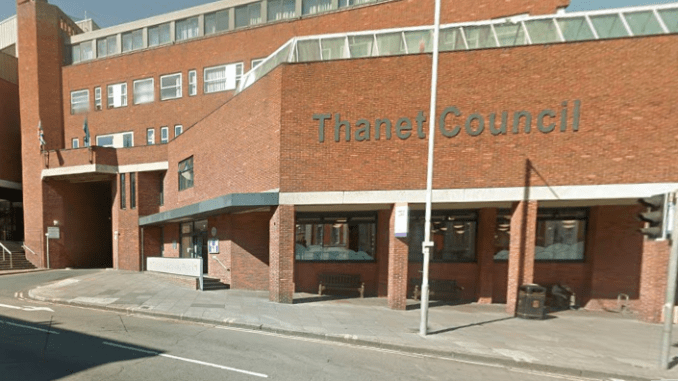
A decision on whether to back proposals to merge Thanet with three other east Kent councils will be made this evening (March 22).
Authority members are to vote on the proposal which would mean Thanet, Shepway, Canterbury and Dover becoming a single authority – the largest of its kind in the country.
The recommendation, made by chief executive Madeleine Homer, for members is: “That having considered the business case it becomes the policy of this council to explore further the abolition of the local government district areas of Canterbury, Dover, Shepway and Thanet and the constitution of a new local government district area of East Kent comprising the areas of those districts.”
If approved, an eight week consultation will launch to seek the views of residents on the future options for East Kent.
The merger would result in the loss of 150 jobs – mainly from management – but, the councils believe, will save £6.8 million in the first two years.
A document to councillors states: “Local Government faces the combined changes of increased demand for services coupled with further downward pressure on funding. In order to take the steps required to make services more efficient, local government may need to be transformed and redesigned around new models.
“Furthermore, the Government has announced that by 2020, local authorities will be entirely dependent upon the income from local taxation (business rates and council tax) for their core funding, as core grant funding from central Government will be phased out.
“Debates on the structure of local authorities and the viability of the two-tier system are nothing new, but they have been re-energised by the prospect of devolution, public sector reform and long-term changes to local government financing.”
Savings
The business case document adds: “Under a prudent scenario agreed with the councils’ Section 151 officers, the combined savings that would need to be identified by 2024/25, if the four districts continued to operate individually, are estimated to be £18.1m1, with £4.7m of these required prior to any merger.
“Of the remaining £13.4m, this business case identifies c. £6.8m of savings that could be achieved within two years of merging, largely made up of staff savings through structural changes and some consolidation of services.”
To create the council it will cost £6.8m – exactly the amount saved over 2 years -covering redundancy costs, merging of technology, communications and engagement. However, the report identifies a further £3.5m in savings potential.
A Statement of Intent was agreed between the councils and Ashford Borough Council, which later pulled out, in July.
Axing services
A report by TDC chief executive Madeleine Homer says if a merged council were not to go ahead TDC may have to consider reducing and axing services, as well as hiking up fees.
She states: “If there was no new council and Thanet carried on as a separate council, we estimate that of the £13m to £21m of savings by 2024-25 needed for four councils, Thanet’s projected savings are in the order of £3.9m to £6m a year by 2024-25.
“In the absence of the opportunity to make savings in senior management, member’s allowances and support, premises, etc afforded by the creation of a new single council, alternative measures would have to be considered. These could include reducing services, terminating services the council does not have to provide by law, and significant increases in fees and charges.”
Next steps
- Public consultation and engagement period 24 March – 19 May 2017
- Decision by each council whether to proceed with project for a new East Kent Council – July 2017
Provisional timetable
- Proposals to create a new council submitted to DCLG (demonstrating clear political commitment from Districts involved) July 2017
- DCLG works with East Kent councils to formulate the Order July to Autumn 2017
- Secretary of State agrees order for formal approval by the four council’s Autumn 2017
- Final decisions by Secretary of State Autumn 2017
- DCLG to prepare necessary statutory instruments modifying existing legislation where required (in order to establish new organisation, wind up the old ones and make transitional arrangements) Autumn 2017
- Each council invited to give formal consent to creation of the new entity Autumn 2017
- New entity considered by Houses of Parliament Autumn 2017
- Secretary of State decision Autumn 2017
- Boundary Commission undertake electoral review (NB this is optional but preferred approach of DCLG – alternative is an othat creates a new council, using temporary wards as basis for the first election, and subsequent election boundaries considered by Boundary Commission). Autumn 2017 to Autumn 2018
- Establish Implementation Executive or similar body (which will be the decision making body until members of the new authority are elected) Nov / Dec 2017
- Agree initial structure for the new council Dec 2017
- Likely TUPE consultation period commences (to be confirmed on the basis of legal advice) Dec 2017 / Jan 2018
- Implementation Executive commences recruitment of senior posts (externally advertised ) Early 2018
- Implementation Executive agrees council tax harmonisation 2018 discretionary order with DCLG Implementation Executive sets first year budget for the new authority and council tax rate Late 2018/ early 2019
- First year budget for the new authority and council tax rate confirmed by all councillors Late 2018/ early 2019
- New council legally takes effect (Vesting Day) April 2019
- Elections to new council May 2019

